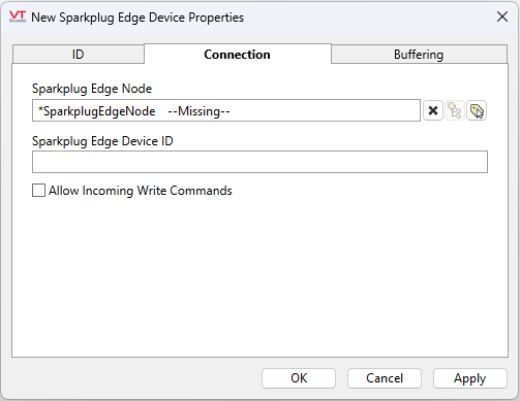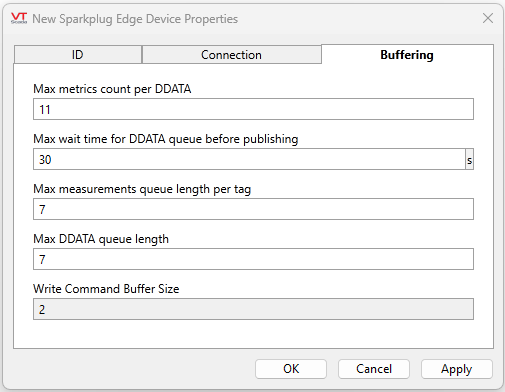Sparkplug Edge Device
The Edge Device tag is always the child of an Edge Node tag. It is the muster point for a logical group of devices such as all devices registered on a single PLC. It is intended to model an Edge Device like a PLC or industrial controller in a Sparkplug B environment.
The ID tab of every tag includes the same common elements: Name, Area, Description, and Help ID.
Name:
Uniquely identifies each tag in the application. If the tag is a child of another, the parent names will be displayed in a separate area before the name field.
You may right-click on the tag's name to add or remove a conditional start expression.
Area
The area field is used to group similar tags together. By defining an area, you make it possible to:
- Filter for particular tag groups when searching in the tag browser
- Link dial-out alarm rosters to Alarm tags having a particular area
- Limit the number of tags loaded upon startup.
- Filter the alarm display to show only certain areas.
- Filter tag selection by area when building reports
When working with Parent-Child tag structures, the area property of all child tags will automatically match the configured area of a parent. Naturally, you can change any tag's area as required. In the case of a child tag, the field background will turn yellow to indicate that you have applied an override. (Orange in the case of user-defined types. Refer to Configuration Field Colors)
To use the area field effectively, you might consider setting the same Area for each I/O driver and its related I/O tags to group all the tags representing the equipment processes installed at each I/O device. You might also consider naming the Area property for the physical location of the tag (i.e. a station or name of a landmark near the location of the I/O device). For serial port or Roster tags, you might configure the Area property according to the purpose of each tag, such as System or Communications.
You may define as many areas as you wish and you may leave the area blank for some tags (note that for Modem tags that are to be used with the Alarm Notification System, it is actually required that the area field be left blank).
To define a new area, type the name in the field. It will immediately be added. To use an existing area, use the drop-down list feature. Re-typing an existing area name is not recommended since a typo or misspelling will result in a second area being created.
There is no tool to remove an area name from VTScada since such a tool is unnecessary. An area definition will exist as long as any tag uses it and will stop existing when no tag uses it (following the next re-start).
Description
Tag names tend to be brief. The description field provides a way to give each tag a human-friendly note describing its purpose. While not mandatory, the description is highly recommended.
Tag descriptions are displayed in the tag browser, in the list of tags to be selected for a report and also on-screen when the operator holds the pointer over the tag’s widget. For installations that use the Alarm Notification System, the description will be spoken when identifying the tag that caused the alarm.
The description field will store up to 65,500 characters, but this will exceed the practical limits of what can be displayed on-screen.
This note is relevant only to those with a multilingual user interface:
When editing any textual parameter (description, area, engineering units...) always work in the phrase editor. Any changes made directly to the textual parameter will result in a new phrase being created rather than the existing phrase being changed.
In a unilingual application this makes no difference, but in a multilingual application it is regarded as poor practice.
Help Search Key
Used only by those who have created their own CHM-format context sensitive help files to accompany their application.
Sparkplug Edge Device properties Connection tab

Sparkplug Edge Node
The Sparkplug Edge Node tag through which the Sparkplug Edge Device tag will communicate. This will automatically link to the parent Sparkplug Edge Node tag or you can select a specific Sparkplug Edge Node tag.
Sparkplug Edge Device ID
The topics namespace for Sparkplug B has the following format: namespace/group_id/message_type/edge_node_id/[device_id]. Sparkplug Edge Device ID is the device_id in this format. Auto-generated unless specified. By default, this ID will include any parent tags and the tag name with the slash (\) substituted with two underscores (__) to keep the ID unique. For example, Edge Device tag "EoD1" appearing under a Sparkplug Edge Node tag "EoN1" which is under a context tag "Weather Station" will auto-generate the Sparkplug Edge Device ID "Weather Station__EoN1__EoD1". Topic names are case-sensitive.
Allow Incoming Write Commands
Enables the Edge Device tag to receive, process, and execute DCMD write commands. There is a buffer size determined by the Write Command Buffer Size in the Buffering tab.
Sparkplug Edge Device properties Buffering tab

You can specify parameters related to queueing values from different I/O metrics linked to the Sparkplug Edge Device for DDATA publishing. The Sparkplug Edge Node has a queue for each of its devices dedicated to buffering incoming DDATA messages. The DDATA queue is encoded into a DDATA message and handed to the Sparkplug Edge Node to be buffered and published either when the maximum queue length has been reached or when a configured length of time has passed.
Max metrics count per DDATA
The maximum length of the DDATA queue. A buffering algorithm goes through all the I/O metrics attached to the Edge Device in a round-robin fashion and picks the oldest value from the metrics queue to buffer in the DDATA queue.
It is a best practice to configure the max metrics count per DDATA to equal the number of metrics attached to the device as long as the size of the resulting DDATA message is not too large to fit in an MQTT payload and if it does not put a heavy load on the network.
Max wait time for DDATA queue before publishing
A maximum amount of time, in seconds, to wait before the DDATA queue is encoded into a DDATA message and handed to the Edge Node to be buffered and published.
Max measurements queue length per tag
Values produced by an IO tag are inserted into a queue for that tag. The queueing algorithm goes through the tags values queues in a round-robin fashion until it fills the DDATA queue of the device. If a new value is produced by the IO tag but the tag's queue is full, the oldest value in the queue is dropped and the new value is queued.
Max DDATA queue length
This is the maximum number of metrics inserted into a DDATA message for a device.
Write Command Buffer Size
Defines the maximum number of write commands that each attached tag can buffer simultaneously. This setting applies to all tags attached to the same Edge of Device (EoD) tag. The minimum buffer size is 2.
